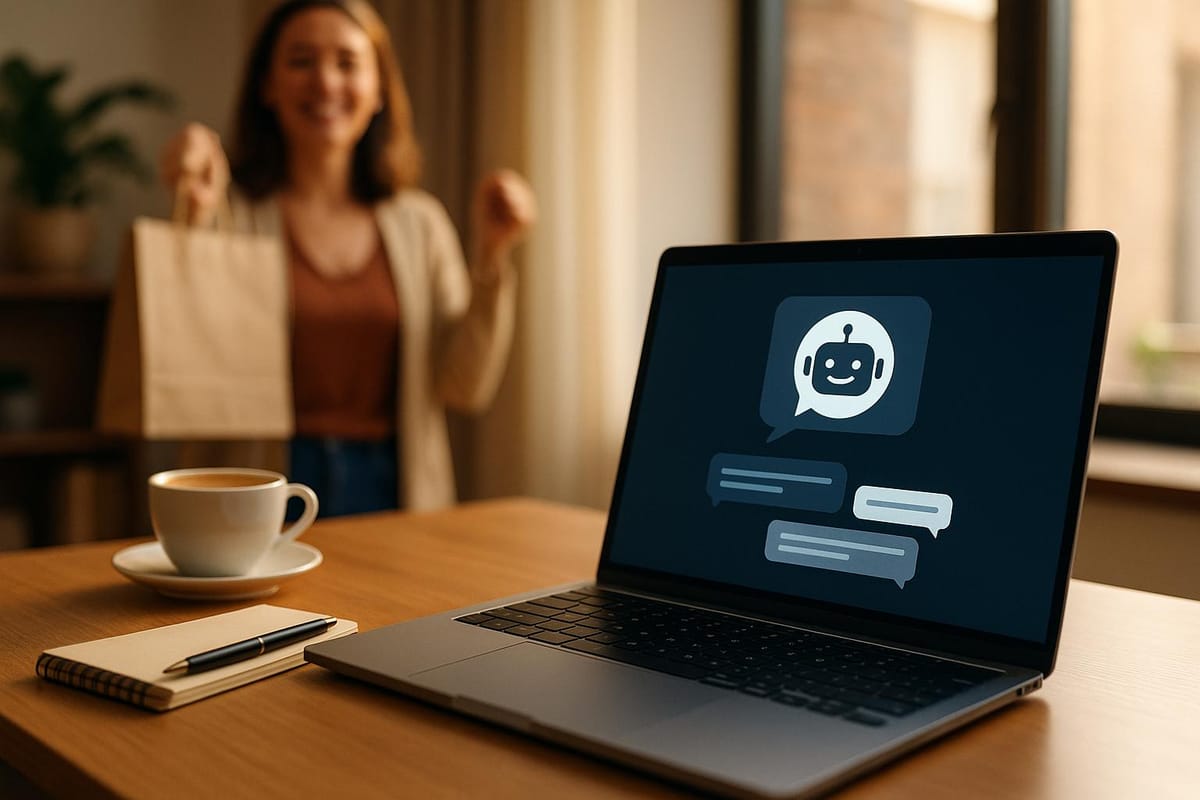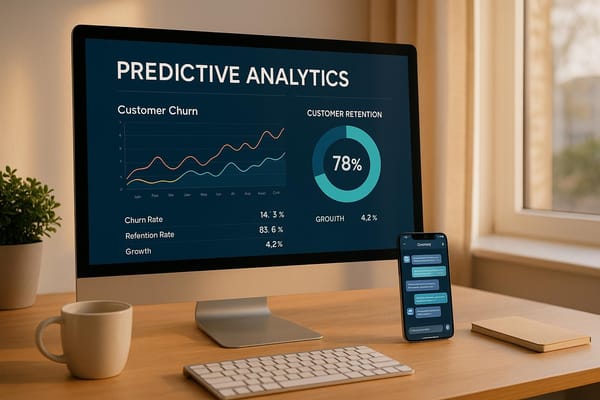How AI Chatbots Turn Customer Inquiries into Paid Conversions
Learn how AI chatbots can enhance sales by transforming customer inquiries into personalized, timely recommendations and boosting conversion rates.

AI chatbots can help businesses turn customer questions into sales by:
- Boosting Sales: Businesses report up to a 67% increase in sales and a 10%-100% rise in website conversion rates.
- Personalized Recommendations: Chatbots analyze customer behavior and suggest tailored products or services.
- 24/7 Availability: They engage customers anytime, ensuring no sales opportunities are missed.
- Upselling and Cross-Selling: Bots suggest complementary products at key moments, like during checkout.
- Human Handoff for Complex Queries: High-value customers can be seamlessly transferred to sales teams.
For example, KLM's chatbot grew leads by 40%, and H&M's chatbot increased online sales by 15%. Chatbots can also cut response times, improve customer satisfaction, and reduce costs, making them a powerful tool for small businesses aiming to grow revenue.
Building Chatbot Workflows That Drive Sales
Once you understand how AI chatbots can turn questions into sales, the next step is designing workflows that consistently drive revenue. The secret lies in crafting interactions that feel less like a sales pitch and more like a helpful, tailored conversation.
Connecting Customer Needs to Sales Goals
AI chatbots are great at identifying what customers need by analyzing their responses and asking smart follow-up questions. Using natural language processing (NLP) and machine learning, these bots can understand the context of a conversation and offer personalized suggestions based on customer data.
The trick is training your chatbot to pick up on specific pain points during a chat. For instance, if a customer says they’re looking to "cut down on monthly expenses", the chatbot should recognize this as a cost-saving concern and suggest budget-friendly products or bundles.
A great example comes from H&M’s chatbot on Kik. It asks users to choose from outfit options, builds a unique style profile, and then recommends a personalized outfit with a combined price. Similarly, the Commonwealth Bank of Australia’s chatbot, CommBank, streamlines business banking by instantly answering queries, cutting down on the need for FAQs or call centers, and improving the overall customer experience.
To make this work, keep your chatbot's knowledge base updated with the latest product details and customer expectations. Use real customer data to simulate common scenarios during training, ensuring responses feel natural and genuinely helpful. Once the chatbot meets initial customer needs, you can introduce additional offers seamlessly.
Creating Conversation Paths for Additional Sales
Upselling and cross-selling through chatbots is all about the right timing and tone. The goal is to enhance the customer’s experience without coming across as pushy.
Timing is everything. Suggest complementary products or upgrades at key moments - like when a customer is checking out, adding items to their cart, or comparing options. These are the moments when they’re most open to recommendations.
For instance, you might use phrases like, "Customers who bought this also liked…" to naturally suggest related products. Offering multiple options at different price points can also be effective. Say a customer is considering a basic service plan; the chatbot could respond with, "For just $10 more a month, you can get unlimited data, so you can stream music anytime without worrying about overages."
To figure out what works best, try A/B testing different conversation flows. Incentives like small discounts, loyalty points, or timely deals can also encourage larger purchases without feeling like a hard sell.
Another effective strategy is programming your chatbot to suggest products based on what’s in the customer’s cart. For example, if someone adds a laptop, the bot might recommend accessories like a laptop bag, an extended warranty, or software packages - offering value that’s directly tied to their purchase.
Transferring High-Value Customers to Sales Teams
While chatbots excel at handling routine queries, knowing when to involve a human is key - especially for high-value sales. Although bots can manage about 79% of basic questions, more complex issues or significant purchases often require the expertise of a sales representative.
A handoff should happen when a query becomes too detailed or when a customer explicitly asks for human help. High-value prospects - like those inquiring about enterprise solutions, bulk orders, or custom packages - often need the nuanced insights that only a human can provide.
Smooth transitions are critical here. Customers shouldn’t have to repeat themselves when switching to a human agent. The chatbot should pass along all relevant details, ensuring the sales rep has full context. Temu’s chatbot handles this well by allowing users to type "I want to talk to a human agent." The bot then connects them to an agent who can review the conversation history for a seamless transition.
MongoDB takes a similar approach, using separate chatbots for sales and product support. If either bot can’t resolve an issue, users can request a human agent who joins the chat with all prior messages in view.
Transparency is crucial during this process. Customers should always know when they’re interacting with a bot and when they’re being transferred to a human. Setting clear options for escalation - like recognizing phrases such as "enterprise pricing" or "custom integration" - helps ensure timely handoffs.
And speed matters. Responding to leads within five minutes makes a company 30 times more likely to convert them. This means sales teams need to act quickly when flagged by the chatbot.
To refine this process, track key metrics like customer satisfaction after agent transfers and conversion rates for bot-to-human handoffs. These insights can help you improve both the chatbot’s performance and the overall sales workflow.
Using Customer Data to Increase Sales
AI chatbots shine in their ability to learn from every customer interaction, transforming into powerful sales assistants that help boost revenue. By analyzing purchase patterns, browsing habits, and customer preferences, these chatbots can offer product suggestions that feel genuinely helpful rather than overly promotional. This approach builds on traditional strategies, turning raw data into actionable insights that directly improve sales outcomes. Let’s break down how specific data points can shape smarter sales strategies.
Using Purchase History for Better Recommendations
One of the most effective ways AI chatbots enhance sales is by analyzing a customer’s purchase history. By understanding what someone has bought before, along with their browsing behavior and preferences, chatbots can make tailored recommendations that feel personal and relevant. Training your chatbot to identify buying patterns allows it to guide conversations toward products or services that truly meet customer interests.
Take Amazon, for example. Their algorithms analyze both individual purchase histories and the buying patterns of similar customers to suggest products that consistently drive additional sales. Sephora does something similar, using AI to recommend makeup and skincare products based on past purchases, skin type, and style preferences. To replicate this success, ensure your chatbot has access to detailed customer profiles, including purchase dates, product categories, and any shared preferences. This enables it to suggest complementary items or bundles - like workout accessories for someone who frequently buys protein powder. Businesses that embrace this level of personalization often see higher engagement and conversion rates. These strategies not only increase average order values but also improve customer lifetime value.
But AI chatbots don’t stop at past purchases - they can also anticipate future needs.
Predicting What Customers Want to Buy Next
AI chatbots go beyond looking at what a customer has already bought - they can predict what they might want next. By analyzing browsing history, search queries, and time spent on certain product pages, these bots can identify patterns and make educated guesses about future needs. Natural language processing also helps chatbots understand the context behind customer queries, adding another layer of personalization.
For instance, Netflix uses AI to recommend shows and movies based on viewing history, ratings, and preferred genres, keeping its suggestions highly relevant. Similarly, Amazon’s recommendation engine suggests new books or products by analyzing both individual purchases and the interests of similar users.
The numbers back this up: 91% of consumers say they prefer brands that provide personalized recommendations, and companies that excel in personalization can see revenue increases of up to 40%.
"Personalization is a way to offer a tailored experience to every user... Good personalization is to the point - it makes the customer feel understood, valued, and comfortable with the insights you have about them." – Kacper Wiacek and Daria Zabój
To build predictive capabilities, gather a wide range of customer data and create real-time user profiles. This allows your chatbot to anticipate needs before customers even express them, leading to more conversion opportunities.
While predicting future needs is powerful, the timing of your offers can make all the difference.
Timing Offers Based on Customer Actions
When it comes to closing a sale, timing is everything. AI chatbots excel at spotting the perfect moment to present deals, discounts, or product suggestions by monitoring real-time customer behavior. Whether it’s cart abandonment, extended browsing, or repeated visits to a specific product page, these behaviors often signal strong buying intent.
Research shows that personalized emails deliver six times higher transaction rates than generic ones, and the same principle applies to chatbot interactions. Sephora’s Facebook Messenger chatbot, Sephora Virtual Artist, is a great example. It lets users virtually try on makeup, increasing conversions by 11% and boosting session engagement by an average of 2 minutes. Similarly, H&M saw a 35% sales lift from chatbot-driven personalized outfit suggestions, and 1-800-Flowers experienced a 70% jump in order value through streamlined chatbot interactions.
"AI is not just a technological shift; it's a strategic lever for creating individualized customer experiences at scale." – Alexander Linden, Research VP at Gartner
To make the most of timing strategies, program your chatbot to recognize key behavioral triggers - like cart abandonment or extended browsing - and automate targeted promotions accordingly. Real-time A/B testing can help fine-tune these strategies for different customer segments. Companies that use customer analytics are 2.6 times more likely to achieve higher ROI. Striking the right balance between well-timed offers and a seamless user experience ensures you maximize conversions while keeping customers engaged, ultimately driving measurable revenue growth.
Measuring and Improving Chatbot Sales Performance
If you want your chatbot to deliver real results, tracking its performance is non-negotiable. By analyzing key sales metrics, you can pinpoint areas for improvement and fine-tune your bot to drive more revenue. Let’s dive into how to measure performance and apply strategies that make a tangible impact.
Tracking Chatbot Conversation Data
To truly understand how your chatbot is performing, you need to go beyond simple message counts. Focus on metrics that reveal how well your bot is converting interactions into sales. For example, engagement metrics tell you how many users interact with your bot and how long they stay engaged. Meanwhile, conversation metrics highlight where users drop off or complete critical actions, like making a purchase or booking a service.
One of the most important metrics to track is the goal completion rate - does your bot guide users to actions like adding items to a cart or scheduling a demo? Beyond that, monitoring fallback rates and conducting sentiment analysis can uncover missed opportunities. Sentiment analysis, in particular, helps you gauge the emotional tone of conversations, which can significantly influence whether customers feel confident enough to make a purchase.
Take Mobily, a telecommunications company in the UAE, as an example. In 2025, they implemented Sprinklr's conversational AI chatbot across 20 different messaging platforms. By analyzing response times and conversation flows, they slashed their first response time from 20 minutes to just six seconds - a 99.6% improvement.
"Before we enabled the chatbot as part of our ecosystem, our average first-response time was 20 minutes. After we enabled the chatbot for all these channels, the response time became six seconds." - Mubarak Alharbi, Mobily
Additionally, tracking message volume is essential for understanding peak usage times and preparing for traffic surges. For instance, marketing campaigns often lead to spikes in chatbot interactions. By segmenting users based on behavior - like new visitors versus returning customers - you can tailor conversation flows to meet their specific needs.
Testing Different Approaches for Better Results
A/B testing is your best friend when it comes to optimizing chatbot performance. Experiment with different conversation flows, call-to-action buttons, and response styles to see what resonates most with your audience. For example, you could test whether a casual tone outperforms a formal one or whether brief responses lead to higher engagement compared to detailed explanations.
You can also tweak UI elements like button colors, placement, and wording to improve click-through rates. Personalized responses based on browsing history or past purchases often outperform generic ones. Even testing different response times can yield insights - some users prefer instant replies, while others might appreciate a slight delay for a more human-like interaction.
Conversational Design, an Italian marketing agency, used systematic testing with Landbot chatbots to great effect. By continuously optimizing conversation paths, they collected over 20,000 leads and achieved a lead conversion rate exceeding 40%. Their efforts also reduced their Cost per Lead by 200%.
"Test your chatbots as a consumer to see their functional limitations and the resulting pain points that lead to negative consumer experiences, lower conversions and loss of brand equity." - Toby Wong, Toby Wong Consulting
Customizing scripts based on user journeys is another powerful tactic. For instance, someone browsing premium products might appreciate detailed feature breakdowns, while a budget-conscious shopper might prefer quick comparisons and a streamlined checkout process. Using sentiment analysis to adjust responses based on a customer’s mood - whether they’re frustrated or excited - can also make interactions more effective.
Adapting to Seasonal Changes and Customer Trends
Seasonal shifts can dramatically influence customer behavior, so your chatbot needs to stay agile. During the holidays, customers might be more concerned with shipping times and return policies, while summer inquiries might center around travel or outdoor products. Adapting to these trends ensures your bot remains relevant.
Real-time data is your ally here. By monitoring conversation topics month by month, you can identify peaks and dips in demand for specific products or services. For example, a Zendesk report found that businesses using AI-powered chatbots could handle 2.5 times more customer inquiries during peak seasons compared to those relying solely on human agents. This scalability is especially valuable during high-traffic periods like Black Friday or holiday sales.
Domino’s provides a great example with their AI chatbot "Dom." During busy times like holidays and game nights, Dom streamlines orders across platforms like Facebook Messenger, Twitter, and Amazon Echo. This not only reduces wait times but also boosts order accuracy when demand is at its highest.
Keep your chatbot’s training data up to date with seasonal trends. For instance, a retailer might prepare for back-to-school shopping by updating product recommendations and inventory details. Restaurants could adjust their bots to promote seasonal menu items or holiday catering options.
Incorporating seasonal themes into your chatbot’s language and recommendations also keeps interactions engaging. Starbucks does this beautifully by introducing holiday-themed content, like promoting pumpkin-spice drinks in the fall. These small touches can make a big difference in maintaining customer interest.
Finally, track engagement patterns throughout the year. Some businesses see chatbot usage spike during lunch breaks, while others peak in the evenings or on weekends. Understanding these patterns helps you allocate resources effectively and ensures your bot is ready to handle high-traffic times that drive the most sales.
How to Set Up AI Chatbots for Small Businesses
Setting up an AI chatbot can be straightforward if you break it into manageable steps. This section outlines how small businesses can configure chatbots to boost sales and improve customer interactions.
Selecting the Right Chatbot Platform
The first step is choosing the platform that aligns with your business goals. Start by identifying what you want to achieve, whether it's cutting costs, increasing sales, or reducing customer support demands. This clarity will shape all your decisions moving forward.
Aron Kale, director of product management at Salesforce AI, highlights this importance: "What is the business outcome you want? For example, reduce cost, increase sales, or minimize customer service volume? Getting really clear on what you want out of your chatbot is an important first step."
Ease of use should be a top priority. Look for platforms with drag-and-drop editors that allow you to design conversation flows without needing to code. A simple, intuitive interface ensures your team can manage the chatbot effectively, and your customers will have a seamless experience.
Multi-channel functionality is another must-have. Your chatbot should work across all the platforms your customers use - your website, Facebook Messenger, WhatsApp, and other messaging apps. This ensures consistent interactions and maximizes sales opportunities.
Scalability is equally important. Choose a platform that can grow with your business, handling more traffic and complex interactions as you expand. Many platforms offer free plans with paid options based on usage, such as the number of conversations or advanced features.
A platform with AI-driven Natural Language Processing (NLP) is essential for creating natural, human-like conversations. This makes it easier for your chatbot to understand customer questions and provide accurate responses.
Lastly, ensure the platform includes analytics and reporting tools to track performance. These tools help you monitor how well your chatbot is meeting its goals and allow you to tweak responses based on customer feedback.
Once you've selected your platform, the next step is to integrate it with your existing business systems.
Connecting Chatbots to Your Business Systems
Integrating your chatbot with your business systems transforms it into a powerful tool for sales and support. In fact, businesses can cut customer service costs by up to 30% by using conversational AI solutions.
Start by linking your chatbot to your CRM and e-commerce platforms. This connection allows the chatbot to access customer profiles, purchase histories, and preferences. With this data, your chatbot can make personalized recommendations, process orders, and log interactions for your sales team to follow up on.
Aron Kale explains, "Think about it in terms of what your human workers need in order to do their jobs well. Those are the same things your chatbot needs. So if you want your chatbot to focus on customer service issues, your chatbot needs to know your policies and look up an order status."
Database connections are also vital. They enable your chatbot to provide real-time information about products, services, and customer accounts. This ensures customers receive accurate, up-to-date details that help them make decisions.
Your chatbot should also be able to track inventory, handle returns, and process orders. Most platforms use APIs to enable these integrations, making the process relatively straightforward. However, thorough testing is essential before launching to ensure everything runs smoothly. Define specific goals for each integration and ensure they align with your overall business objectives.
With your platform and integrations set up, it's time to train your chatbot using your business data.
Teaching Chatbots Using Your Business Data
The foundation of an effective chatbot is a well-built knowledge base. This is where you compile all the information your chatbot needs to assist customers and drive sales.
Pull data from FAQs, customer interactions, support scripts, and reviews to create a comprehensive knowledge base. This helps your chatbot understand how customers talk about your products and services.
Organize your data by customer intents and entities. For example, if a customer says, "I want to buy a laptop under $800", the intent is "purchase", and the entities are "laptop" and "$800."
As Aron Kale notes, "It's really possible to start small and really simple, with things like Q&A and knowledge articles. It doesn't have to integrate to 50 things right away - you can add use cases and expand it to meet different use cases over time."
Next, design conversational flows that guide customer interactions. Think about the logical steps a customer might take, whether they're asking about product features or ready to make a purchase. Tailor these flows to provide the right information at the right time.
Customize your chatbot's tone to match your brand personality. The language should be clear and approachable, making customers feel like they're talking to a helpful team member, not a robot.
Testing is a critical step. Create a list of common customer questions and see how well your chatbot responds. Document any issues, such as incorrect answers, and refine the responses accordingly.
Once your chatbot is live, monitor its performance regularly. Key metrics like response rates, customer satisfaction scores, and abandonment rates can highlight areas for improvement. Use analytics to identify gaps in your knowledge base and update it as needed.
Training your chatbot is an ongoing process. As your business grows and customer needs evolve, your chatbot should adapt to keep delivering value.
Conclusion: Growing Revenue with AI Chatbots
AI chatbots have become a game-changer for small businesses aiming to turn customer inquiries into revenue. The numbers speak for themselves - 99% of businesses using chatbots report a boost in lead conversion rates by at least 10%, and over half (55%) say they’re capturing better-quality leads through these automated tools. These improvements in lead generation set the stage for meaningful revenue growth.
But the benefits don’t stop there. According to McKinsey, companies leveraging AI for personalized customer experiences can increase their revenue by as much as 40%, aligning with the 91% of consumers who now expect tailored recommendations. Personalization has become a must in today’s marketplace, and chatbots deliver it efficiently.
The operational perks are equally impressive. While human agents typically handle 35–50 queries a day, chatbots can manage over 200, offering the scalability that growing businesses crave. This efficiency ensures businesses can meet increasing customer demands without overextending their resources.
The adoption of AI tools is accelerating at a striking pace. In sales, AI usage jumped from 24% in 2023 to 43% in 2024, and the Artificial Intelligence in Small and Medium Business Market is projected to grow from $27.99 billion in 2025 to a staggering $87.87 billion by 2034. That’s a compound annual growth rate of 13.55%, reflecting the growing confidence in AI’s ability to drive revenue.
Another standout advantage is 24/7 customer support. Chatbots eliminate wait times, preventing lost sales opportunities. They also reduce abandoned cart rates by 7–25%, directly impacting the bottom line.
Think of your AI chatbot as more than just a tool - it’s an investment in your business’s future. With well-defined goals, high-quality training data, and seamless system integration, chatbots can become powerful revenue engines that grow alongside your business.
For small businesses looking to thrive in today’s competitive digital landscape, AI chatbots offer a clear path to higher conversions, lower costs, and steady revenue growth. This isn’t experimental technology anymore - it’s a proven solution delivering real results.
FAQs
How do AI chatbots identify customer needs and turn them into sales?
AI chatbots rely on natural language processing (NLP) and machine learning to interpret customer questions and understand their needs. By analyzing conversations as they happen, these chatbots can pinpoint issues like confusing product descriptions or slow response times and deliver instant, customized solutions.
They also collect valuable data on common problems and customer preferences, enabling businesses to fine-tune their services and boost satisfaction. By tackling concerns head-on and guiding users through the sales journey, chatbots not only keep customers engaged but also drive purchases. In fact, companies using chatbot technology have seen sales increase by as much as 23%, along with stronger customer loyalty.
With real-time insights and personalized recommendations, AI chatbots go beyond solving problems - they open doors for upselling, cross-selling, and fostering lasting customer relationships.
How can I ensure a seamless transition from an AI chatbot to a human sales representative?
To ensure a smooth transition from a chatbot to a human sales representative, it’s important to establish clear guidelines for when the handoff should occur. For example, this could include situations like handling complex questions or addressing high-value leads. Equally important is having human agents ready to step in immediately, reducing wait times and maintaining customer trust and satisfaction.
When the switch happens, make sure the sales representative has access to the full chat history and relevant customer details. This allows them to continue the conversation seamlessly without forcing the customer to repeat themselves. An integrated platform that connects your chatbot with your human team can help keep the process smooth and the interaction natural.
How can small businesses use AI chatbots to improve customer service and increase sales?
Small businesses can improve customer interactions and increase sales by incorporating AI chatbots into their systems. To get started, pinpoint areas where a chatbot can make a difference - think about answering customer questions, streamlining support, or assisting users during the buying process. Make sure the chatbot works well with your existing tools, such as CRM platforms or e-commerce software, so everything runs smoothly.
To ensure the chatbot is effective, train it with common customer questions and scenarios. This step is crucial for providing accurate and helpful responses. Plus, AI chatbots can use real-time analytics to learn and adjust based on customer behavior, which means better engagement and more conversions. By automating tasks like upselling and cross-selling, chatbots not only save time and resources but also help businesses increase their revenue.





